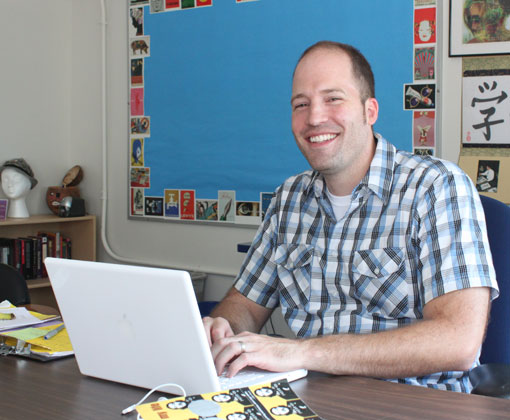When Beaver launched its 1:1 laptop initiative in 2009, some worried that using computers in the classroom would create distracted, isolated students—a valid concern in this day and age. Like many, I am disgusted when I look around a crowded café or sidewalk and see pallid faces buried in digital devices, ignoring everyone and everything else. Imagining a similar tableau in a classroom is frightening. The reality of the wired classroom is quite different, however, and after the program’s successful inaugural year, the majority of students and faculty look favorably upon the change. I would venture to say that each of my faculty colleagues had their own “aha” moment last year, when they and their students realized the power of instructional technology to transform their learning experience.
It started with a question: “Can’t we do something?” I was beginning a unit on Harriet Jacob’s narrative, Incidents in the Life of a Slave Girl, in my 10th grade English class. To help students make personal connections between their lives and the time of the Trans-Atlantic Slave Trade, I had vetted several online sources that explored modern forms of slavery with the idea that a class period of research would help my students delve deeper into a complex issue. I was so utterly wrong. We did achieve personal connections and close textual analysis, but not in the way I planned. My students showed me a better path.
The inquisitive sophomore went on to explain—in a sincere and respectful tone—that Beaver does an excellent job of making students aware of social justice issues. He felt, however, that too often this study remained abstract. He wanted to do something about the issue of slavery, not just discuss it in relation to the text. A quick survey of the other students showed they agreed. It was a classic teachable moment. I could see the students were genuinely interested in the topic and decided, on the spot, to scrap my plans. The students and I constructed a new unit instead, and the three weeks that followed were some of the most successful, enriching, and edifying I have had in my thirteen years in the classroom.
The modern slavery unit was truly student-centered and student-generated. They devised the various components of the unit while I acted as a coach, and they collaborated with every other sophomore taking English that term to determine the scope and sequence of our study. In the end, they decided to create public service announcement videos exposing modern instances of forced or child labor and to launch letter-writing campaigns to corporate leaders and government officials. All the while, we made connections between this work and our reading of Harriet Jacob’s memoir. The end result was so much more meaningful than I had ever imagined (visit: www.tinyurl.com/BCDSslavery).
Now, such learning can and should occur in any classroom, regardless of the resources available. Yet because of our laptop program this particular unit was much more productive and meaningful. Students still worked in groups, using face-to-face interactions to brainstorm, research and edit, but the laptops extended this collaboration beyond the classroom walls and the school day.
My students used Google Docs, which allows many authors to work on one document. Because each student had a laptop, he or she could add to the group’s research log whenever it was most convenient. This asynchronous collaboration is a powerful addition to group work, allowing even the most reticent student to make meaningful contributions at a personal pace.
Also, by using a class wiki—a web page that allows for many editors at one time—students shared resources not only with group members, but also with students in other classes. Sarah Akhtar’s 10th grade English sections, interested in the approach my students were taking, quickly joined in. When someone found a useful link, they added it to the class wiki and everyone benefited. My list of initial sources rapidly blossomed into a rich and organic resource far richer than anything we could have done individually.
The work we accomplished was more efficient as well. A common concern people have about laptops in the classroom is that they create too many distractions. Yet, I have found that having laptops actually saves time and helps the class move at a faster pace. When the laptops are not needed, they are simply closed.
The biggest benefit from the laptop program has been the way it helps create authentic audiences for the students’ writing. They were no longer writing just for me, but for the world beyond our classroom walls. I installed a visitor-tracking map on our wiki, and by the next day our site had visits from Japan, Jakarta, and cities all over the U.S. As the week continued, we received more and more hits. For generations, teachers have understood that writing is more effective when it is purposeful and focused; using the Web as a communication platform, students discovered that others are interested in what they have to say. The realization that their voices can hold influence and garner reactions from the wider world was transformational and a lesson that will last a lifetime.
Robin Neal teaches upper school English and serves as the faculty’s technology integration specialist. He joined the Beaver faculty in 2009 from the Frankfurt International School, where he was a leader in the inventive use of classroom technology.

